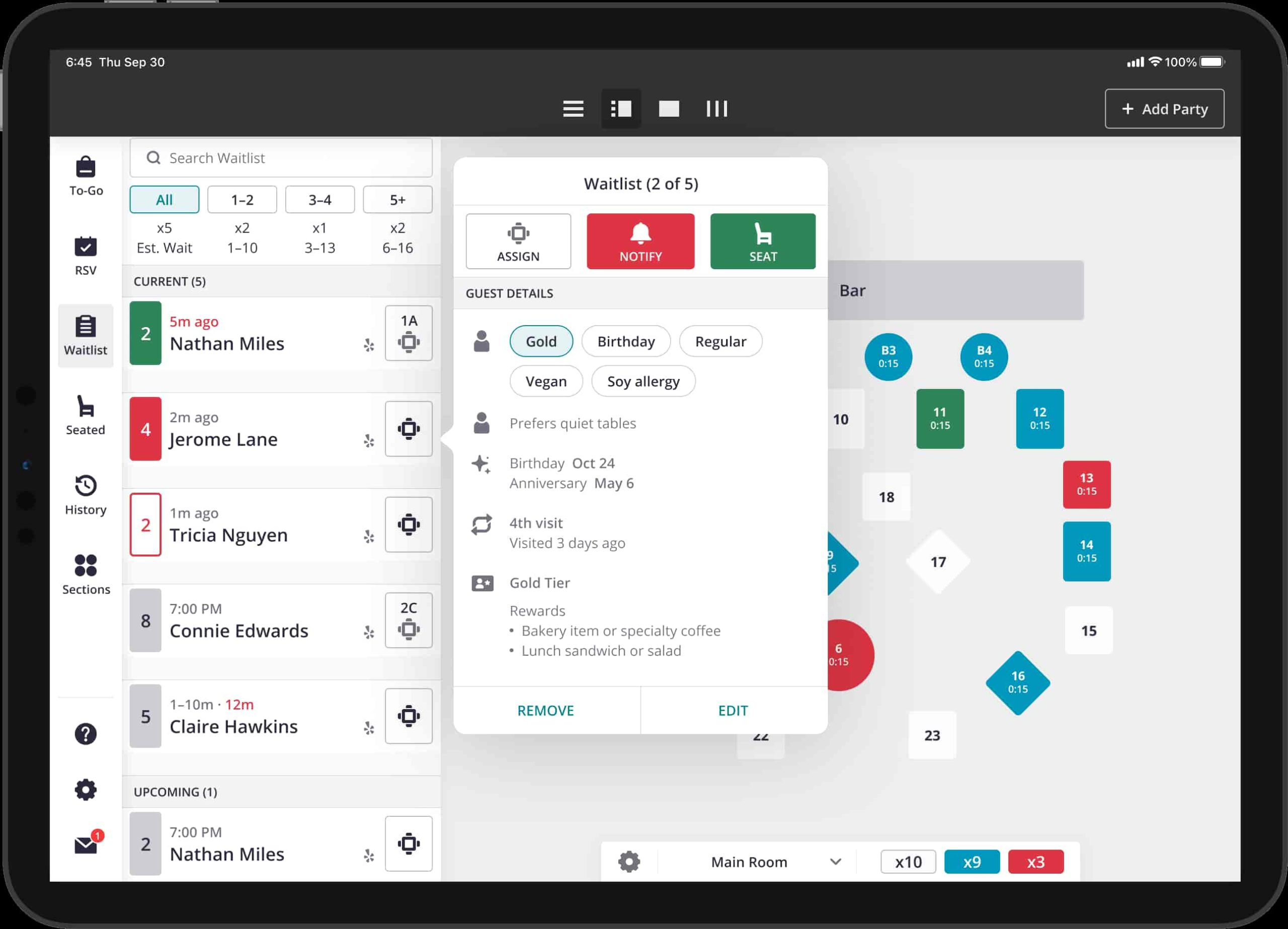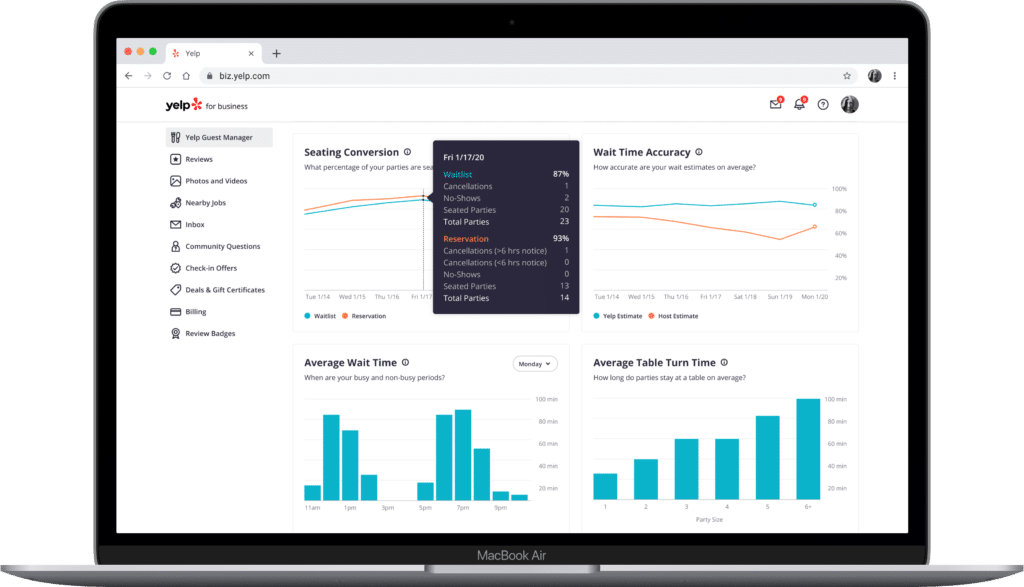Yelp took a big step towards restaurant operational management today with the launch of Yelp Guest Manager. This extends Yelp’s role from SMB marketing to operational support — a natural expansion that’s been ongoing at Yelp and aligned with several macro trends in SMB SaaS (more on that in a bit).
As for the tool itself, Yelp Guest Manager rolls up existing Yelp products with some new features into a single-source platform. The idea is that the collective feature set is a comprehensive “front-of-house” restaurant management system. That includes everything from loyalty programs to reservations.
In addition to a one-stop-shop play, Yelp has aligned Guest Manager features with Covid-era (and post-Covid) demand signals. That includes digital ordering, delivery, pickup and even a dedicated function for the growing cloud kitchens trend. Guest Manager pricing starts at $249 per month.
“With today’s launch of Yelp Guest Manager, we aim to help restaurateurs and their staff better manage guests across their dining experience by simplifying time-consuming front-of-the-house tasks, so hosts can focus on providing hospitality to their guests,” Yelp VP of Product Anthony Cross told Localogy Insider. “Whether it is using Yelp Kiosk to manage walk-ins and reduce crowding in a restaurant’s waiting area or using Yelp to manage takeout orders, technology can help ease the burden restaurants face when adopting a new operating model.”
Under the Hood
Going Deeper on Yelp Guest Manager, what’s under the hood? As noted, the headline for the new rollout is comprehensiveness in front-of-house restaurant operational functions. This includes existing Yelp products as well as new features and integrations, as detailed below.
Existing Yelp products aggregated into Guest Manager
Reservations & Waitlist: Enables restaurants to easily integrate digital reservations and waitlists into their Yelp page and websites, providing diners the opportunity to join the waitlist from home (or elsewhere), with accurate seat times and live status updates that helps reduce no-shows and line-abandonment for restaurants.
Table management and POS features: Gives hosts and servers what they need for smooth front-of-house operations including custom floor maps and sections, as well as integrations with POS and other systems.
Takeout: Lets restaurants add takeout orders, track them, and notify guests via text message when their food is ready for pick up.
Kiosk: Helps teams focus on hospitality by allowing diners to check themselves into a digital waitlist upon arrival, and receive automated wait times and text notifications with their table status. Available as an add-on
New features, native to Guest Manager
New Languages: 7 new languages to Yelp Kiosk, allowing for even more customers to seamlessly add themselves to the restaurant’s waitlist so front-of-house staff can focus on hospitality. Available languages include: English, Korean, Japanese, Chinese (simplified and traditional), Spanish, Filipino, and Vietnamese.
Reservation Seating Conversion: Yelp Guest Manager will now allow restaurants to see what percentage of their reservation parties were actually seated in the Business Owner App. This insight will allow restaurants to better measure the effectiveness of their reservation cancellation policies.
Self-Serve Reservation Settings: This new feature will allow restaurants to adjust their reservations capacity directly in the business owner app. Hosts will now be able to modify the minimum or maximum size for reservations, adjust the number of guests or parties that are accepted in 15 minute intervals, and edit the pre-booking notes for guests without contacting the Yelp support team.
Curbside SMS: Yelp Guest Manager will now give the host the option to indicate when an order is curbside and automatically text the consumer with order updates. The confirmation text asks guests to text back when they arrive and provide details, such as their car make and model to help ensure hosts have the information they need to manage and deliver orders efficiently.
Virtual Kitchens: New business attribute that lets cloud kitchens (a.k.a ghost kitchens) identify themselves as such. This correspondingly helps users identify these restaurants nearby if they’re intent on food delivery.
Third-party Integrations
Punnch: an industry-leading loyalty and engagement platform is now directly integrated with Yelp Guest Manager.
Olo: Restaurant partners that are also Yelp Ads customers can now place a pixel (provided by Yelp) on their Olo ordering site, providing the ability to measure and attribute ad-spend impact on view-through and click-through conversions.
The key point in all of the above is consolidation and integration. It’s all about one-stop-shop appeal to busy restaurant owners.
“Restaurants are starting to see some of the hidden costs associated with too many vendors, including lack of integration, device proliferation, and complex processes,” said Cross. “As restaurants move to an omnichannel model they need vendors that are going to help them manage every aspect of their front-of-house.”

Timing & Trending
Back to the broader trend of expanding into SMB operational needs, this is a key market movement under the banner of SMB SaaS. Though the local media and tech sector has for decades focused on SMB advertising, many have realized the opportunity to expand into adjacent operational tools.
These areas are separate from, but often synergistic with, SMB advertising and marketing. They go beyond advertising to fulfill SMBs’ multi-stage operational needs such as payment processing, appointment scheduling, payroll, and customer relationship management (CRM) among others.
The advantages of this product-line expansion include revenue diversification and retention. Bundling SMB SaaS with existing local ad offerings can deepen relationships. That can mean a lock-in effect due to operational reliance, thus mitigating local advertising’s longstanding churn issues.
In addition to the SMB SaaS trend, Yelp Guest Manager meets the moment when it comes to Covid-era demand signals, as noted. In fact searches for takeout are now 77 percent greater than pre-pandemic levels. This triggers the need for systems that bring together online and in-person dining.
“Over the last 18 months, the restaurant industry has been through a significant technology adoption cycle, with many new vendors offering point solutions that support front-of-house operations,” said Cross. “This increase of technology allows restaurants to fulfill more takeout, curbside and delivery orders, in addition to in-person dining, creating new opportunities for restaurateurs to grow.”




